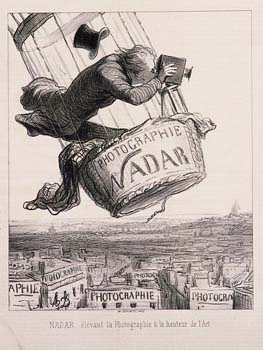Nadar élevant la photographie à la hauteur de l'art (Nadar Raising Photography to the Height of Art)
- 1862
- Honoré Daumier (French 1808-1879)
- Lithograph published in Le Boulevard
28.8 x 22.1 cm., 11-3/8 x 8-11/16" image
- Catherine Carter Goebel, Paul A. Anderson Chair in the Arts Purchase, Paul A. Anderson Art History Collection, Augustana College 2000.28

Essay by Matthew Brownley, Class of 2005 and Catherine Carter Goebel, Editor
Honoré Victorin Daumier was a French artist who delighted a mostly bourgeois audience with his illustrations. Daumier turned his drawings into prints by producing them as lithographs. He enjoyed using this medium because it effectively captured the immediacy of his sketches. Daumier's chosen technique enabled him to reach a larger audience through multiple prints drawn on the lithographic stone—a democratic approach to patronage. During his lifetime he created nearly six thousand lithographs. His early works were characterized by a revolutionary spirit with biting illustrations for La Caricature and Le Charivari, popular journals of the day.
Nadar Raising Photography to the Level of Art (77A) is a piece that really defines Daumier's mature style. It portrays a single subject, as most of his illustrations do, and the drawing is further animated through Daumier's signature lively and energetic lines. As with most of his lithographic production, this work was printed in black and white. It illustrates a gentler side than his earlier political cartoons. Here, he explores the world of modern life, with its innovations and foibles. This lithograph, like most of his illustrations, was published in the press, in this case in Le Boulevard (1862).
An innovative photographer, Nadar was struggling to have his photographs, such as his portrait of Daumier (77B) seen as real works of art. He believed that art could be expressed in many ways, including photography. Nadar would also take bird's-eye view photographs from his hot air balloon in order to achieve the vantage points he desired, in this case, of the city of Paris.
Daumier here illustrates Nadar in his familiar hot air balloon which he dubbed the Giant (77A). He appears as an awkward bourgeois entrepreneur, with hat flying and topcoat disheveled. The windblown effect illustrates the excitement of the aerial feat depicted. The double meaning of this lively cartoon is evident—Nadar is raising photography to the height of art—both physically through his bird's-eye view as well as symbolically with his advocacy for photography's being considered a major art medium, like painting and sculpture.
